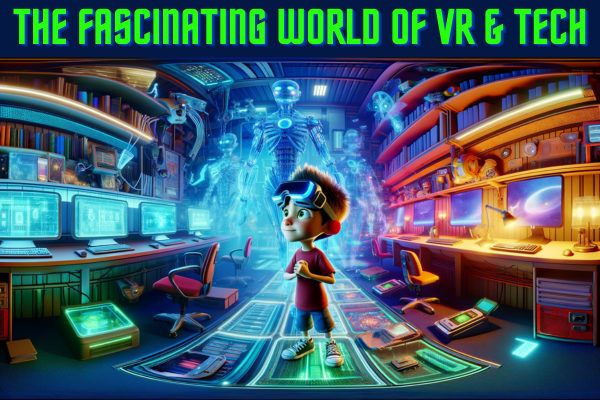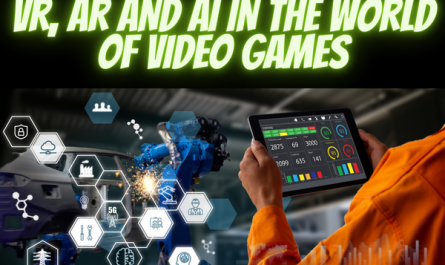Step into a whole new dimension and unleash your inner virtual geek as we embark on an exciting journey into the fascinating world of virtual reality and technology. Prepare to have your mind blown as we dive into the immersive experiences and limitless possibilities offered by this cutting-edge technology.
Virtual reality has evolved from being a wild idea in science fiction to a tangible reality, captivating the masses with its ability to transport us to virtual realms and push the boundaries of what we thought was possible. From gaming to education, medicine to design, virtual reality has found its way into almost every facet of our lives, revolutionizing the way we interact with digital content.
Join us as we explore the latest advancements in virtual reality devices, the mind-boggling applications that are revolutionizing industries, and the impact it has on our daily lives. Discover how virtual reality is reshaping the way we learn, communicate, and even how we experience entertainment.
Are you ready to dive headfirst into the captivating world of virtual reality? Strap on your VR headset, tighten your seatbelt, and get ready for an unforgettable adventure. The future is here, and it’s waiting to be explored.
Table of Contents
The History and Evolution of Virtual Reality Technology
Virtual reality (VR) technology traces its roots back much further than many might realize, with its conceptualization beginning in the mid-20th century. However, it wasn’t until the late 1980s that VR began to gain significant traction and attention. This pivotal period marked the emergence of what we now recognize as the modern era of virtual reality.
One of the key milestones in the development of VR was the creation of the first head-mounted display (HMD) by Jaron Lanier, a pioneer in the field of computer science and virtual reality. Lanier’s invention laid the foundation for the immersive experiences that have since become synonymous with VR technology. This groundbreaking device allowed users to step into virtual worlds and experience digital environments in a way that had previously been confined to the realm of science fiction.
As technology progressed, so too did the capabilities of virtual reality. Advancements in hardware and software have propelled VR into the mainstream, making it more accessible and affordable than ever before. Companies like Oculus, HTC, and Sony have played instrumental roles in driving innovation within the VR industry, investing heavily in research and development to push the boundaries of what is achievable.
Today, virtual reality has evolved into a multifaceted technology with a wide range of applications across various industries. From gaming and entertainment to education and healthcare, VR has found its way into nearly every aspect of modern life. The immersive nature of VR experiences has revolutionized how we interact with digital content, providing new avenues for creativity, learning, and communication.
Looking to the future, the potential of virtual reality appears limitless. As the technology continues to mature and evolve, we can expect even more transformative developments on the horizon. Whether it’s through advancements in hardware, software, or user interfaces, VR is poised to redefine our understanding of reality and reshape the way we experience the world around us.
In summary, the history and evolution of virtual reality technology represent a journey of innovation and discovery. From its humble beginnings as a conceptual idea to its current status as a mainstream technology, VR has undergone remarkable growth and transformation. As we continue to unlock new possibilities and push the boundaries of what is possible, the future of virtual reality promises to be nothing short of extraordinary.
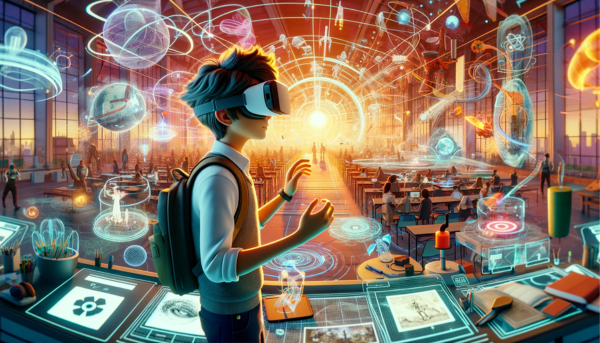
Applications of Virtual Reality in Various Industries
Virtual reality technology is not confined to the realm of gaming; it has permeated various industries, reshaping how we operate, educate, and perceive our surroundings. From architecture and design to healthcare and education, virtual reality (VR) is catalyzing transformative changes across diverse sectors, unlocking innovative possibilities and enhancing efficiency in unprecedented ways.
In the realm of architecture and design, VR has emerged as a powerful tool for visualization and communication. Architects and designers leverage VR to craft immersive, lifelike representations of their projects, enabling clients to embark on virtual walkthroughs and explore every detail before construction begins. This immersive experience fosters better collaboration, facilitates design iterations, and ultimately leads to more informed decision-making processes. Moreover, VR technology enables stakeholders to anticipate spatial challenges and optimize design solutions, resulting in more functional and aesthetically pleasing built environments.
In healthcare, the applications of virtual reality are equally profound. VR simulations are revolutionizing medical training by providing aspiring healthcare professionals with realistic, hands-on experiences in a safe and controlled environment. Surgeons can hone their skills through virtual surgical simulations, replicating complex procedures with remarkable fidelity and without risking patient safety. Furthermore, VR is being employed in the treatment of various medical conditions, ranging from chronic pain management to post-traumatic stress disorder (PTSD) therapy. Immersive VR environments offer patients a therapeutic escape, facilitating relaxation, distraction, and emotional healing.
Education is another sector undergoing a paradigm shift with the integration of virtual reality. VR technology transcends traditional learning methods by transporting students to immersive, interactive environments where they can engage with educational content in unprecedented ways. Whether exploring ancient civilizations in history class, dissecting virtual organisms in biology lab simulations, or practicing language skills through virtual immersion experiences, VR enriches learning experiences, fosters deeper comprehension, and nurtures creativity. Additionally, VR facilitates distance learning initiatives, enabling students to access educational resources and collaborate with peers regardless of geographical constraints.
Beyond these industries, virtual reality continues to find innovative applications in fields such as automotive design, retail marketing, tourism, and entertainment, among others. As VR technology evolves and becomes more accessible, its potential to drive innovation, enhance productivity, and improve quality of life across diverse sectors will continue to expand. Indeed, the captivating world of virtual reality beckons us to embrace its limitless possibilities and embark on a journey of exploration and discovery.
In conclusion, virtual reality’s impact extends far beyond gaming, permeating various industries and reshaping the way we work, learn, and experience the world. From enhancing design visualization in architecture to revolutionizing medical training and therapy, VR technology is propelling us into a future where immersive experiences redefine human interaction, creativity, and problem-solving. As we harness the transformative power of virtual reality, the boundaries of innovation continue to expand, inviting us to unleash our inner virtual geek and embark on an exhilarating journey of discovery and innovation.
Benefits of Virtual Reality Technology
Furthermore, virtual reality offers unparalleled opportunities for training and skill development across numerous professions. Whether it’s mastering intricate surgical procedures in medicine, refining technical skills in engineering, or honing customer service abilities in hospitality, VR simulations provide a safe and realistic environment for learners to practice and refine their expertise. This not only enhances proficiency but also reduces the risk associated with real-world training scenarios, ultimately leading to improved performance and increased confidence among practitioners.
In addition to its educational and training applications, virtual reality technology holds immense potential for therapeutic interventions and mental health treatment. VR-based therapies have been successfully utilized to treat various psychological disorders, including anxiety disorders, phobias, and PTSD. By exposing individuals to controlled virtual environments that evoke specific stimuli or triggers, therapists can facilitate gradual desensitization and symptom management in a controlled and supportive setting. Moreover, VR therapy offers a level of customization and flexibility that traditional therapeutic approaches often lack, allowing for tailored interventions that cater to individual needs and preferences.
Beyond its individual benefits, virtual reality technology is driving innovation and transformation across entire industries, leading to increased productivity, cost savings, and competitive advantage. In manufacturing and product design, VR enables engineers and designers to collaborate seamlessly, visualize concepts in three dimensions, and identify potential design flaws before production begins. This streamlines the product development process, accelerates time-to-market, and reduces prototyping costs, ultimately enhancing overall efficiency and profitability.
Furthermore, virtual reality has the power to democratize access to experiences and opportunities previously limited by geographical, physical, or socioeconomic barriers. Through VR-enabled telepresence and virtual meetings, individuals can connect and collaborate regardless of their location, fostering global cooperation and cultural exchange. Similarly, VR-based travel experiences allow individuals to explore distant destinations and immerse themselves in different cultures, promoting empathy, understanding, and cross-cultural communication.
In summary, the benefits of virtual reality technology are multifaceted and transformative, spanning education, training, healthcare, industry, and beyond. By harnessing the immersive power of VR, we can unlock new realms of possibility, enriching lives, expanding horizons, and redefining the way we work, learn, and interact with the world around us. As we continue to innovate and explore the potential of virtual reality, the opportunities for growth, discovery, and human advancement are limitless. Strap on your VR headset and prepare to embark on a journey into the captivating world of virtual reality, where the future is limited only by our imagination.
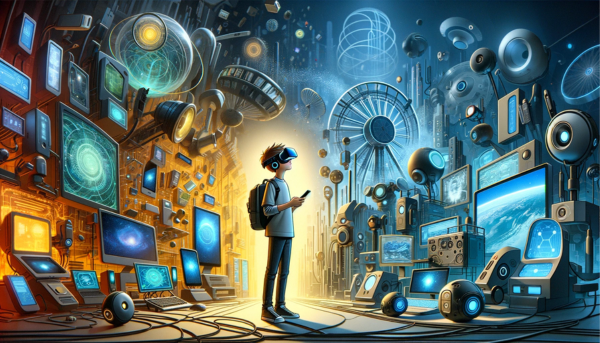
Popular Virtual Reality Devices and Platforms
Moreover, smartphone-based VR solutions, such as Google Cardboard and Samsung Gear VR, have democratized virtual reality experiences by leveraging the computing power of smartphones to deliver immersive content. These affordable and portable devices provide entry-level access to virtual reality, allowing users to enjoy a variety of VR applications and experiences without the need for specialized hardware.
In recent years, augmented reality (AR) devices have also gained prominence, offering a blend of virtual and real-world elements. Devices like Microsoft HoloLens and Magic Leap One enable users to interact with digital content overlaid onto their physical environment, opening up new possibilities for gaming, productivity, and communication. While AR differs from traditional VR in its approach, both technologies share the common goal of enhancing human experiences through immersive digital environments.
Furthermore, social VR platforms such as Facebook Horizon and VRChat have emerged as hubs for social interaction and virtual collaboration. These platforms enable users to connect with friends, explore virtual worlds, and participate in shared activities, fostering a sense of presence and community in the virtual realm. With features like customizable avatars, interactive environments, and real-time communication tools, social VR platforms offer a compelling alternative to traditional social networking experiences.
As virtual reality continues to evolve, new devices and platforms are constantly being developed, pushing the boundaries of what’s possible and expanding the reach of immersive technologies. Whether it’s through standalone headsets, smartphone-based solutions, or augmented reality devices, the world of virtual reality offers a diverse array of options for users to explore, interact, and create. Strap on your VR headset and prepare to embark on an unforgettable journey into the captivating world of virtual reality, where the possibilities are limited only by your imagination.
Virtual Reality Gaming and Entertainment
The integration of virtual reality (VR) technology into gaming and entertainment has transformed the way we experience digital content, offering unparalleled levels of immersion and engagement. In the realm of gaming, VR has revolutionized traditional gameplay mechanics, providing players with a sense of presence and agency within virtual worlds that was previously unimaginable.
Virtual reality gaming transports players into fully immersive environments where they can interact with objects, engage in dynamic gameplay, and experience thrilling adventures firsthand. Whether exploring fantastical realms, solving intricate puzzles, or engaging in intense multiplayer battles, VR gaming offers a level of immersion that transcends traditional gaming experiences. With the ability to look around, move freely, and physically interact with virtual objects, players are transported to the heart of the action, resulting in heightened sensory experiences and unparalleled levels of excitement.
Moreover, virtual reality has expanded beyond traditional gaming experiences to encompass a diverse range of entertainment options. VR movies, documentaries, and immersive experiences allow audiences to step into the shoes of characters, explore breathtaking landscapes, and embark on thrilling journeys, all from the comfort of their own homes. Whether witnessing historical events firsthand, diving into underwater worlds, or soaring through outer space, VR entertainment offers a level of immersion and engagement that is unmatched by traditional media formats.
In addition to passive entertainment experiences, virtual reality has also transformed live events and performances, offering audiences the opportunity to participate in immersive experiences like never before. Virtual reality concerts, sporting events, and cultural performances allow viewers to teleport to front-row seats, interact with performers, and experience the energy and excitement of live events from anywhere in the world. With VR technology, the possibilities for immersive entertainment are endless, offering audiences new ways to engage with content and creators to push the boundaries of storytelling and creativity.
As virtual reality technology continues to evolve, the future of gaming and entertainment promises even greater levels of immersion, interactivity, and innovation. From immersive storytelling experiences to interactive multiplayer adventures, VR is reshaping the way we play, watch, and engage with digital content, ushering in a new era of entertainment where the boundaries between reality and imagination blur. Strap on your VR headset and prepare to embark on an unforgettable journey into the captivating world of virtual reality gaming and entertainment, where the possibilities are limited only by your imagination.
Virtual Reality in Education and Training

Virtual Reality in Healthcare and Therapy
The integration of virtual reality (VR) technology into healthcare and therapy represents a paradigm shift in the way medical professionals diagnose, treat, and manage various conditions, offering innovative solutions that enhance patient outcomes and quality of life.
In healthcare, virtual reality is revolutionizing pain management and rehabilitation practices by providing patients with immersive and interactive experiences that distract from discomfort and facilitate healing. VR-based distraction techniques have been shown to reduce perceived pain levels and anxiety during medical procedures, such as wound care, dental treatments, and chemotherapy infusions. By transporting patients to virtual environments filled with engaging activities and calming scenes, healthcare providers can alleviate distress and enhance patient comfort without relying solely on medication.
Furthermore, virtual reality is increasingly being utilized in physical and cognitive rehabilitation programs to support patients recovering from injuries, surgeries, or neurological conditions. VR simulations offer tailored exercises and activities that challenge patients’ motor skills, cognitive abilities, and balance, promoting functional recovery and independence. From virtual reality-enhanced physiotherapy sessions to immersive cognitive training programs, VR technology provides personalized and motivating rehabilitation experiences that accelerate recovery and improve overall outcomes.
In the realm of therapy, virtual reality offers transformative interventions for individuals struggling with mental health disorders, including post-traumatic stress disorder (PTSD), phobias, and anxiety disorders. By exposing patients to virtual environments that simulate triggering situations or stimuli, therapists can guide them through gradual exposure exercises to desensitize and reprocess traumatic memories or fears. VR-based exposure therapy provides a safe and controlled environment for patients to confront their fears, develop coping strategies, and achieve lasting symptom relief.
Moreover, virtual reality enables therapists to customize treatment experiences to meet individual patient needs, preferences, and therapeutic goals. From virtual reality relaxation exercises to mindfulness-based VR interventions, therapists can tailor immersive experiences that address specific symptoms and promote emotional regulation and resilience. By leveraging the power of VR technology, therapists can enhance therapeutic engagement, improve treatment adherence, and empower patients to reclaim control over their mental health and well-being.
As virtual reality technology continues to advance, the potential for its applications in healthcare and therapy is limitless. From pain management and rehabilitation to mental health treatment and beyond, VR offers innovative solutions that redefine the way we approach patient care and wellness. Strap on your VR headset and embark on an immersive journey into the captivating world of virtual reality healthcare and therapy, where the future of healing is limited only by our imagination.
Future Trends and Advancements in Virtual Reality Technology
The future of virtual reality (VR) technology promises to be an exhilarating journey filled with groundbreaking innovations and transformative advancements that will redefine the way we interact with digital content and experience the world around us. From cutting-edge hardware developments to pioneering software solutions, the future of VR holds limitless potential for immersive experiences and unprecedented levels of realism.
One of the most anticipated advancements in VR technology is the integration of haptic feedback systems, which will enable users to feel tactile sensations and interactions within virtual environments. By incorporating haptic feedback gloves, vests, and controllers, VR experiences will become even more immersive, allowing users to sense textures, vibrations, and physical interactions with virtual objects. This heightened sense of touch will enhance realism and presence, further blurring the boundaries between the virtual and real worlds.
In addition to haptic feedback, advancements in eye tracking technology are poised to revolutionize VR interactions and user experiences. Eye tracking sensors will enable VR systems to accurately detect and analyze users’ eye movements, allowing for dynamic foveated rendering techniques that optimize graphics rendering based on gaze direction. This not only improves performance and visual fidelity but also enables more natural and intuitive interactions within virtual environments, such as gaze-based navigation and object interaction.
Furthermore, the future of VR is characterized by the proliferation of wireless connectivity solutions, eliminating the need for cumbersome cables and tethered setups. Wireless VR headsets will offer users greater freedom of movement and flexibility, enabling untethered experiences that enhance immersion and comfort. With advancements in wireless technology, such as 5G connectivity and low-latency wireless protocols, VR experiences will become more accessible and seamless, empowering users to explore virtual worlds without constraints.
Another exciting trend in the evolution of VR technology is the convergence of virtual reality with other immersive technologies, such as augmented reality (AR) and mixed reality (MR). By combining VR with AR and MR, developers can create hybrid experiences that seamlessly blend digital content with the real world, unlocking new possibilities for gaming, entertainment, education, and enterprise applications. This convergence will enable users to interact with virtual objects and information overlaid onto their physical surroundings, blurring the lines between physical and digital realities.
As VR technology continues to advance, the future holds limitless possibilities for innovation and exploration. From immersive haptic feedback systems to seamless wireless connectivity and the convergence of VR with other immersive technologies, the future of virtual reality promises to push the boundaries of what’s possible and revolutionize the way we perceive, interact with, and experience digital content. Strap on your VR headset and prepare to embark on an unforgettable journey into the captivating world of virtual reality, where the future is limited only by our imagination.
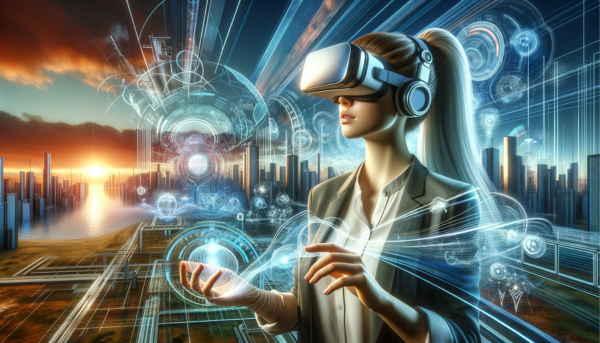
Conclusion: Embracing the Virtual Reality Revolution
Virtual reality has emerged as a transformative force, reshaping industries, enriching experiences, and pushing the boundaries of what’s possible in the digital realm. From its humble beginnings as a science fiction concept to its current status as a tangible reality, VR has captivated the masses with its immersive experiences and limitless potential.
As technology continues to advance, the future of virtual reality holds boundless opportunities for innovation and exploration. From gaming and education to healthcare and entertainment, VR is revolutionizing how we interact with digital content and experience the world around us. Its impact is profound and far-reaching, transcending traditional boundaries and opening new frontiers for creativity, collaboration, and discovery.
So, as we embark on this exhilarating journey into the captivating world of virtual reality, let us embrace the revolution with open arms and eager minds. Let us strap on our VR headsets, tighten our seatbelts, and dive headfirst into a realm of endless possibilities. For the future is here, and it’s waiting to be explored.
As we unleash our inner virtual geeks, let us remember that the power of virtual reality lies not only in its technology but also in our imagination and creativity. Let us harness this power to shape a future where virtual reality enriches lives, fosters connections, and inspires change. Together, let us embrace the virtual reality revolution and embark on an unforgettable adventure into a world where the only limit is our imagination.

